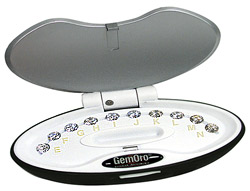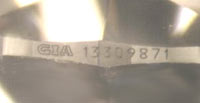Contact
Click below to speak to a Diamond Consultant or customer service.
or
Live Chat8:00 am - 6:00 pm CST (Mon - Fri)

Click below to speak to a Diamond Consultant or customer service.
or
Live Chat8:00 am - 6:00 pm CST (Mon - Fri)
Often, a customer will shop for a diamond using a traditional jeweler, even if they eventually purchase online. The buyer is able to see various diamond sizes, shapes, and qualities first hand; allowing for a more informed and confident online purchase (aware that "actual" images shown online are often nothing of the sort). In some cases, the customer may decide to purchase from the local jeweler based on their service and selection. In either case, when shopping for a diamond at a traditional jeweler, keep the following in mind:
The number one mistake made when purchasing a diamond is to be misled on cut quality. Cut is more difficult to define than color or clarity, and therefore often ignored or misrepresented. Common issues include:
FTC guidelines for jewelry retailers state that any seller-stated color or clarity grade must be within 1 grade of what it is appraised at by a qualified independent appraiser. This means that if you purchase a diamond that the seller represents as G / VS2, and it later appraises as H / SI1, you have no legal recourse with the jeweler. Unfortunately, this leeway encourages jewelers to inflate their grades; a jeweler who is confident he has a G color diamond is free to represent it as an F.
It is impossible to accurately judge the clarity and color of a diamond once it is set. Flaws are easily hidden under prongs, and color is obscured by the reflections from the setting itself. Unless it is GIA certified, do not purchase a diamond over $2,000 without seeing it loose (preferably with a magnifier), so that you can see firsthand what you are getting.
Color grading is notoriously difficult. GIA goes to great lengths to create standardized environments and training for color grading. Do not accept the jeweler's grade as a substitute. While color grading for small accent diamonds is commonly given in ranges (e.g. G-H color); for a center diamond, accept only reputable lab grading. If a jeweler gives a color range on a center diamond (e.g. "This diamond is color grade G / H") you can be sure the diamond has not been graded by any lab, much less GIA, and the color grade is not reliable.

If you have doubts about the color grade you are given on a diamond, ask the jeweler if you can compare it to his in-house master color set. A master color set is a standardized set of cubic zirconia stones showing the various color grades. By holding your diamond up to the master set, you should be able to see where it fits on the GIA color spectrum.
Without a master set, or other objective measure, be very careful when comparing color in diamonds. By making invalid comparisons, a jeweler can often sell a customer up on color. For example, a customer is shown two diamonds, one described as "G" color, one described as "H" color; the customer sees that the color distinction is obvious, and decides they should move to the higher color. However, problems with this approach include:
Jewelry store lighting is designed to make diamonds look their best (for example, using specialized lighting to emit a spectrum shifted towards blue will make a yellow diamond appear whiter). When considering any diamond, ask to see the diamond in normal lighting, meaning out from under the spotlights. Options include taking the diamond outside the showroom area where standard office lighting is prevalent, or to a skylight, atrium, window or direct sunlight. You will want to see how your diamond looks under these conditions since they will be the norm once you own the diamond.
Be aware that diamond carat weights are often rounded up. For instance, a .69 carat diamond might be described as 3/4 carat. While this is an accepted norm non-certified diamonds (e.g. earrings and small accents), it is not acceptable for a certified or primary diamond. Always ask for the exact carat weight, and the price per carat, so that you can easily and accurately compare diamonds.
Ask to see a copy of the GIA Grading Report for any diamond you are considering. Do not purchase from a jeweler who is unwilling or unable to show you the certificate for a diamond prior to purchase. (Learn more about certification.)
Understand the distinction between a GIA certified diamond and a diamond that has been certified by a GIA trained gemologist. In the first case, the diamond has been graded at an independent GIA facility, in a standardized environment, by GIA technicians who have issued a GIA grading report for the diamond. In the second case, the diamond has been graded by a jewelry store employee who has been trained by GIA. The diamond has no GIA certification, and it is unlikely that the diamond was actually graded in strict accordance with GIA standards.
Remember that roughly 1/3 of diamonds have been treated in some way (Lumera does not sell treated diamonds). While these treatments may make a diamond look better, they can have a negative impact on both the value and stability of the stone. One benefit of diamonds certified by a reputable lab is that any treatment will be prominently disclosed. Without this disclosure, it is impossible for the average customer to recognize a treated diamond.
Often, diamonds (and settings) offered in a jewelry store have no price tag, only a style number or bar code. Alternatively, the jeweler may have a price printed, but use a calculator to figure the discount on each diamond you ask about. Both situations allow the retailer to adjust the price on the spot, based on what he believes you are willing to pay. Be very careful, as the retailer has more experience and more information than you do.
Diamonds virtually never sell for less than their true market value. Sales and coupons do not offer the opportunity to purchase a diamond for less than its value, only for less mark-up than the days it is not on sale. Traditional jewelry stores carry a much higher mark-up on diamonds than do online retailers. However, in return you receive face to face service and a chance to see the diamond before you buy.
Most jewelers offer a set of warranties and/or guarantees with every purchase. While return and trade-in guarantees are valuable (provided there is no fine print), other offers may be of less value than they first appear. When reviewing a jeweler's policies, always:
If you need to leave your diamond with a jeweler (to have it set in a ring, or to have an existing ring cleaned or repaired), but are concerned about the (remote) possibility that the jeweler may switch your diamond for a diamond of lesser value, take one or more of the following precautions:

Get more advice on how to choose a diamond using our step by step guide.

